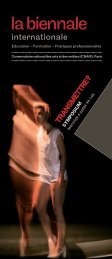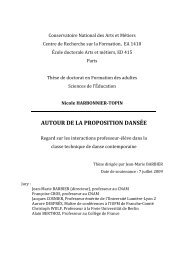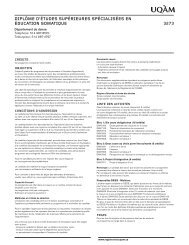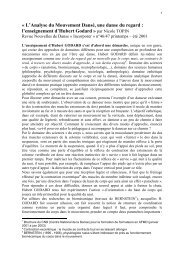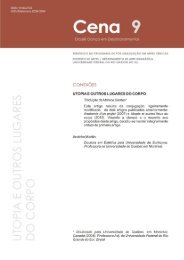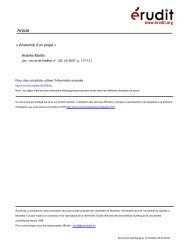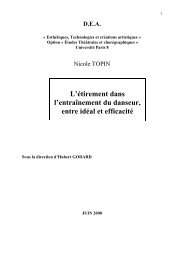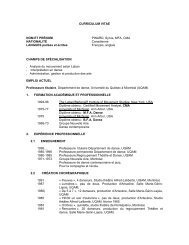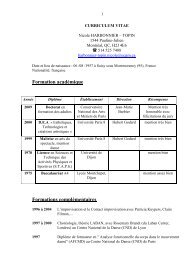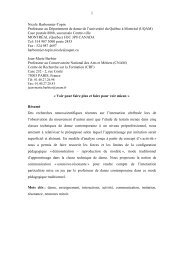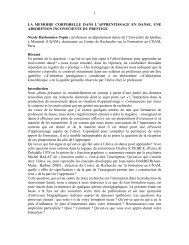Day 2 - Département de danse - UQAM
Day 2 - Département de danse - UQAM
Day 2 - Département de danse - UQAM
Create successful ePaper yourself
Turn your PDF publications into a flip-book with our unique Google optimized e-Paper software.
of this form of performance. Through the case studies of The Ri<strong>de</strong> (the performance of my 2008 horseback ri<strong>de</strong> across<br />
Canada); productions by Cavalia, Canada’s equestrian ballet company; and the equestrian cabarets of France’s Théâtre<br />
Zingaro, I explore the manners of human/equine collaborative performance in an attempt to further <strong>de</strong>fine the parameters of<br />
inter-species performance. At the core of non-invasive equestrian is a subtle, human/equine reciprocal interaction, in which a<br />
circulation of intent, energy and action results in two animals performing together—an inter-species performative exchange.<br />
If not all acts that engage humans and non-human animals are inter-species, but rather that there is a spectrum of<br />
engagement, from animals in performance to inter-species collaboration, what are the characteristics that incite inter-species<br />
performance? I propose that inter-species performance is not a fixed state, but rather a continual negotiation that ebbs and<br />
flows with both parties involved, and that it is in the nuances of this engagement that the inter-species quality of a performance<br />
may be found.<br />
12:30pm-2:00pm<br />
Lunch & Launch<br />
George<br />
Lunch courtesy of Talonbooks, featuring Lucia Frangione, an award-winning playwright and actor. Her twenty plays have<br />
been produced by theatres such as The Belfry Theatre, Alberta Theatre Projects, Lambs Players San Diego, Ruby Slippers,<br />
Solo Collective, Chemainus Theatre, and Prairie Theatre Exchange. Lucia resi<strong>de</strong>s in Vancouver and is a member of the<br />
Playwrights Guild of Canada.<br />
2:15pm-5:30pm<br />
a) No Happy Endings: What Can Applied Theatre Really Do? George<br />
Seminar Organizers: Warwick Dobson (University of Victoria), Monica Pren<strong>de</strong>rgast (University of<br />
Victoria), Lauren Jerke (University of Victoria). Participants: Matthew “Gus” Gusul (University of<br />
Victoria), Kathy Bishop (University of Victoria), Amy Clausen (University of New Brunswick), Kimberly<br />
Richards (University of Calgary), Nikki Shafeeullah (University of Alberta, 2013 CATR Intercultural<br />
theatre award winner), Danette Boucher (University of Victoria), Trudy Pauluth-Penner (University of<br />
Victoria), Warren Linds (Concordia University), Bronwyn Preece (University of Victoria), Sandra<br />
Chamberlain-Sni<strong>de</strong>r (University of British Columbia), Babatun<strong>de</strong> Bakare (Stellenbosch University,<br />
South Africa), Aida Jordão (University of Toronto), Ursula Neuerburg-Denzer (Concordia University)<br />
In the wake of the October Revolution, Lenin said: Theatre is a weapon to be used in the service of the socialist revolution.<br />
Latterly, the i<strong>de</strong>a that theatre is a weapon has become an article of faith for most applied theatre practitioners; and many an<br />
extravagant claim has been ma<strong>de</strong> by those who see theatre as a powerful means of ameliorating the conditions of the<br />
vulnerable, the marginalized and the oppressed.<br />
In the past fifty years, a large number of well-meaning, good-intentioned projects with ambitious aims have taken place<br />
globally—all, no doubt, fuelled by the hope of a truly happy ending. But what kinds of happy endings are we legitimately<br />
entitled to expect from our en<strong>de</strong>avors?<br />
This seminar seeks to pose one question that applied theatre practitioners have traditionally been reluctant to engage<br />
with: What can applied theatre really do? By posing this question, we hope to encourage practitioners to re-discover the<br />
irrefutable role that art plays in the impact of their work.<br />
Using this question as a framework to gui<strong>de</strong> our seminar, we will look at selected graduate stu<strong>de</strong>nts’ projects from the<br />
University of Victoria over the past <strong>de</strong>ca<strong>de</strong>. We will also look at accepted participants’ projects from the rest of Canada or<br />
elsewhere. The projects will be grouped together thematically according to the extra-theatrical purposes that we have<br />
i<strong>de</strong>ntified at UVic: theatre used for (1) educational purposes, for (2) community building, or (3) to address social change. We<br />
will evaluate each project by asking the question, what did it really do? And how do we know?<br />
Ultimately, we hope that practitioners and researchers will leave with an increased un<strong>de</strong>rstanding of what theatre can<br />
legitimately claim to do. Specifically, we expect that this seminar will better enable participants to make <strong>de</strong>liverable promises to<br />
the communities with which they work.<br />
2:15pm-3:45pm<br />
b) Fictive Transitions, from the “Real” through “Performance” Bishop<br />
Open Panel Mo<strong>de</strong>rator: Paula Sperdakos (University of Toronto)<br />
“Nina Arsenault’s 40 <strong>Day</strong>s and 40 Nights: Teetering on the Edge of Discovery.” Judith Rudakoff<br />
(York University)<br />
In 40 <strong>Day</strong>s and 40 Nights, the exploration of the body as home was part of an ongoing ritual investigation: if the<br />
constructed vessel, the body, is home, how does the inner, authentic Nina house herself in it? How does the living home<br />
nurture, challenge, cradle, even reject the being living within it??<br />
13



